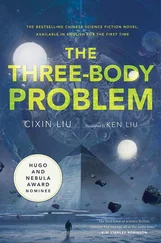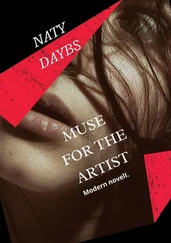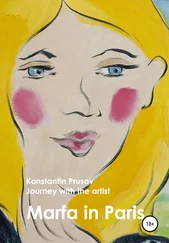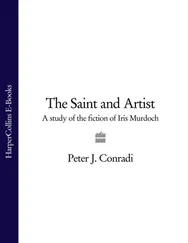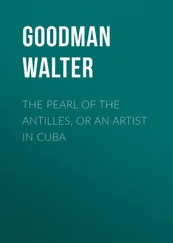When mixing any of these colours it is as well to bear in mind that the increments to change the colour may be very small, so colour testing on an adjacent piece of paper will help to avoid disappointment. Be brave, be bold!
Plums and Roses
47 × 57 cm (18 1/ 2× 22 1/ 2in)
I tried to obtain the strength of colour in this painting by contrasting the deep-toned primaries with pale secondaries and even paler neutrals. The greys were all mixed to complement the vibrancy of the yellows, so where the yellows tended towards orange the greys were bluer, but where the yellows were more green the greys had more red in them. This is not a hard and fast rule, but it pays to think about it .

Coombe Courtyard
57 × 76 cm (22 1/ 2× 30 in)
The strength of colour in the painting is due to the preponderance of primary and secondary colours, which have been used unadulterated by mixing on the paper rather than in a palette. One other way of ensuring the clarity of the colour is to employ the white line technique to ensure that passages of colour do not overlap and thereby cause unnecessary tertiary mergings .
5
TIDE LINES
How do I make my boat and harbour scenes look more convincing?
Answered by:
Ray Balkwill
For many artists there is nothing more inspiring than sketching or painting in a bustling harbour. It is also one of my favourite subjects to paint. So why do many painters find the subject so difficult?
Perhaps it is because harbours hold so much subject material in such a confined space. A jumble of buildings, boats, people, mud, water, and much more, is a lot to take in and can be confusing at first sight. Another problem is the tide; the whole scene can change completely in a matter of minutes. Many students seem to find drawing boats difficult, too, and the thought of groups of tourists peering over their shoulder can be a daunting one – particularly if they have never drawn a boat before. ‘I can’t draw boats ’ is something I frequently hear on my courses.
Quayside, Looe
26.5 × 36.5 cm (10 1/ 2× 14 1/ 2in)
Here I particularly liked the contrast of sand, still reflections and moving water, with the tide on the turn. I added some of the highlights using white gouache. Remember, light boats reflect darker and vice versa .
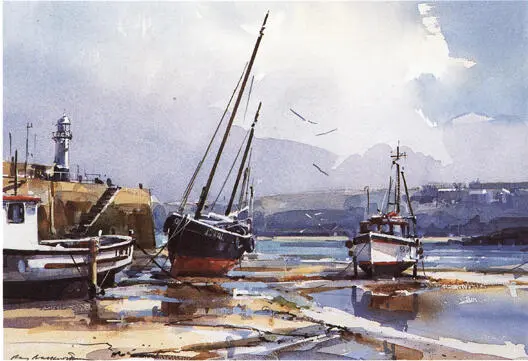
Low Tide, St Ives
26.5 × 36.5 cm (10 1/ 2× 14 1/ 2in)
This painting of the harbour at St Ives, Cornwall, was done from a sketch and photograph. St Ives is all about light, so here the sky in the painting plays a big part. The verticals – the lighthouse and masts on the boats – are also important as they link the sky to the landscape .
The reasons are numerous, but many students have never even tried to draw boats. Many feel nervous because they know nothing about them. However, drawing and painting boats well does not mean that you have to fully understand their construction, though it helps if you have a little knowledge, or certainly an interest in the subject.
We tend to draw what we know from experience, rather than what we see with our eyes. Therefore, observing both objectively and analytically is something you must learn to do if you wish to improve your marine scenes. More often than not, boats are the focal point of a painting; it is important they are accurately portrayed, or at least look seaworthy. That does not necessarily mean adding more detail. What you leave out is often more important than what you put in.
The materials you choose for sketching will depend on your own preferences. Mine consist of an A3 cartridge pad, black felt-tip pens, charcoal and Conté crayon. I also use a smaller A4 landscape sketchbook for watercolour as well as tinted pastel paper (stretched) for watercolour and gouache.
There are no short cuts to drawing boats; it is a case of measuring and checking relative heights and widths and making constant comparisons of proportions. I find boats more interesting when they are viewed in three dimensions; that is, where the viewpoint is such that the length, width and depth of the boat can all be seen. However, I often like the simpler, two-dimensional view, which may be the boat side-on, or perhaps looking from the bow or stern.
Boats can be a real problem if the tide is in and they are moving about in the water. But do not let that put you off; just decide on the best position of the boat, be patient and work quickly. Remember, though, the chances are that it could be taken out on a fishing trip at any time!
Many of my paintings are done at low tide. This is for a number of reasons, the most obvious being that the boats do not move around. But I also find that the whole structure is visually far more interesting. When they are tilted on the mud, as in Low Tide, St Ives , their masts create further compositional interest. I also find that low tide can create far more interesting shapes and contrasts than high water. Tidepools, seaweed, ropes and rusting chains can be exciting elements in a painting, of which Polperro Harbour on is a good example.
Making boats ‘sit’ on the mud, or float on the water is another common problem. Many students do not make the shadows, or reflections, quite dark enough, so that boats ‘float’ in mid air. With watercolour I often merge a wet-into-wet wash of the keel into the sand or water, making it difficult to distinguish between the two.
Photograph of Polperro Harbour
Choosing your viewpoint and your eye level is very important. You will find boats viewed from the quayside, where you have to look down on them, quite difficult as you will have to consider perspective and foreshortening.
Let us imagine you are on one of my painting courses and we go together to the picturesque harbour of Polperro, in Cornwall. Take a look at the photo above. This complicated harbour scene is typical, and shows the many problems you could be faced with. It is rare to find a perfect ready-made scene – you have to create one for yourself. There are many options and permutations in every scene and, in fact, you will never exhaust the endless possibilities.
To see what I mean, have a look at the examples here, where I have arranged the elements in each picture in order to make a composition that works, based on the view above. Most marine subjects are painted in a landscape format, because this creates a sense of openness. But do not necessarily go for the obvious. You may find that a portrait, a square, or even a long narrow format is more challenging and works much better. To simplify the scene, I used three boats in each of the examples.
Конец ознакомительного фрагмента.
Текст предоставлен ООО «ЛитРес».
Прочитайте эту книгу целиком, купив полную легальную версию на ЛитРес.
Безопасно оплатить книгу можно банковской картой Visa, MasterCard, Maestro, со счета мобильного телефона, с платежного терминала, в салоне МТС или Связной, через PayPal, WebMoney, Яндекс.Деньги, QIWI Кошелек, бонусными картами или другим удобным Вам способом.



